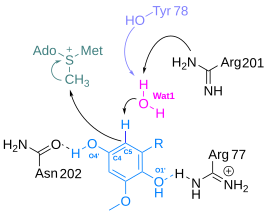Biology:Coenzyme Q5, methyltransferase
 Generic protein structure example |
| 2-Methoxy-6-polyprenyl-1,4-benzoquinol methylase | |||||||||
|---|---|---|---|---|---|---|---|---|---|
| Identifiers | |||||||||
| EC number | 2.1.1.201 | ||||||||
| Databases | |||||||||
| IntEnz | IntEnz view | ||||||||
| BRENDA | BRENDA entry | ||||||||
| ExPASy | NiceZyme view | ||||||||
| KEGG | KEGG entry | ||||||||
| MetaCyc | metabolic pathway | ||||||||
| PRIAM | profile | ||||||||
| PDB structures | RCSB PDB PDBe PDBsum | ||||||||
| Gene Ontology | AmiGO / QuickGO | ||||||||
| |||||||||
Coenzyme Q5, methyltransferase, more commonly known as COQ5, is an enzyme involved in the electron transport chain.[1][2][3][4] COQ5 is located within the mitochondrial matrix and is a part of the biosynthesis of ubiquinone.[5]
Function
COQ5 has the role of catalyst in the C-methylation in the coenzyme Q biosynthesis,[5] on the benzoic ring of CoQ6, the biosynthetic intermediate,[6] in both in humans and yeast Saccharomyces cerevisiae.[5] COQ5 is one of the eleven polypeptides in yeast, that are essential for Q production. Moreover, it assembles with the CoQ-synthome, a multi-subunit complex. In humans, primary Q deficiency happens due to many COQ genes mutating. And diseases such as mitochondrial, cardiovascular, kidney and neurodegenerative diseases, are results of the decrease in Q biosynthesis.[5] Development of soluble COQ5 proteins can be applied to other mitochondrial proteins. Coenzyme Q10 Deficiency is associated with COQ5. Therefore, to maintain CoQ10 levels in human cells, COQ5 is required.[6][7]
Catalytic activity
Catalyzes C-methylation and ubiquinone biosynthetic process.[8]
Mechanism
COQ5 is an S-adenosyl methionine (SAM)-dependent methyltransferase (SAM-MTase) catalyzing the C-methylation step, converting 2-methoxy-6-polyprenyl-1,4-benzoquinone (DDMQH2) to 2-methoxy-5-methyl-6-polyprenyl-1,4-benzoquinone (DMQH2) in the CoQ6 biosynthesis pathway.[9]
In the catalytic mechanism of COQ5, based on the structural analyses, as the first step, before methyl transfer, Arg201 abstracts a hydrogen from the water molecule, forming a negatively charged oxygen atom which deprotonates the C5 atom of DDMQH2. Looking at the DDMQH2 substrate and Asn202, the hydroxyl group on the C4 atom and the side chain forms a hydrogen bond which leads to the formation of the O4′ anion. The stability of the C5 anion is a result of the negative charge being delocalized on the π bond conjugation system. Tyr78 acts as a catalytic base and Tyr78, Arg201 and Asn202 are invariant in COQ5 homologues.[9][10]
References
- ↑ "A C-methyltransferase involved in both ubiquinone and menaquinone biosynthesis: isolation and identification of the Escherichia coli ubiE gene". Journal of Bacteriology 179 (5): 1748–1754. March 1997. doi:10.1128/jb.179.5.1748-1754.1997. PMID 9045837.
- ↑ "Characterization and genetic analysis of mutant strains of Escherichia coli K-12 accumulating the biquinone precursors 2-octaprenyl-6-methoxy-1,4-benzoquinone and 2-octaprenyl-3-methyl-6-methoxy-1,4-benzoquinone". Journal of Bacteriology 105 (3): 769–778. March 1971. doi:10.1128/jb.105.3.769-778.1971. PMID 4323297.
- ↑ "The COQ5 gene encodes a yeast mitochondrial protein necessary for ubiquinone biosynthesis and the assembly of the respiratory chain". The Journal of Biological Chemistry 272 (14): 9175–9181. April 1997. doi:10.1074/jbc.272.14.9175. PMID 9083048.
- ↑ "Characterization of the COQ5 gene from Saccharomyces cerevisiae. Evidence for a C-methyltransferase in ubiquinone biosynthesis". The Journal of Biological Chemistry 272 (14): 9182–9188. April 1997. doi:10.1074/jbc.272.14.9182. PMID 9083049.
- ↑ 5.0 5.1 5.2 5.3 "Molecular characterization of the human COQ5 C-methyltransferase in coenzyme Q10 biosynthesis". Biochimica et Biophysica Acta (BBA) - Molecular and Cell Biology of Lipids 1841 (11): 1628–1638. November 2014. doi:10.1016/j.bbalip.2014.08.007. PMID 25152161.
- ↑ 6.0 6.1 "Detection of suppressed maturation of the human COQ5 protein in the mitochondria following mitochondrial uncoupling by an antibody recognizing both precursor and mature forms of COQ5". Mitochondrion 13 (2): 143–152. March 2013. doi:10.1016/j.mito.2013.01.007. PMID 23354120.
- ↑ "Disruption of the human COQ5-containing protein complex is associated with diminished coenzyme Q10 levels under two different conditions of mitochondrial energy deficiency". Biochimica et Biophysica Acta (BBA) - General Subjects 1860 (9): 1864–1876. September 2016. doi:10.1016/j.bbagen.2016.05.005. PMID 27155576.
- ↑ "COQ5 Gene - Coenzyme Q5, Methyltransferase". GeneCards human gene database. Weizmann Institute of Science. https://www.genecards.org/cgi-bin/carddisp.pl?gene=COQ5.
- ↑ 9.0 9.1 "Crystal structures and catalytic mechanism of the C-methyltransferase Coq5 provide insights into a key step of the yeast coenzyme Q synthesis pathway". Acta Crystallographica. Section D, Biological Crystallography 70 (Pt 8): 2085–2092. August 2014. doi:10.1107/s1399004714011559. PMID 25084328.
- ↑ "Crystal structures of mycolic acid cyclopropane synthases from Mycobacterium tuberculosis". The Journal of Biological Chemistry 277 (13): 11559–11569. March 2002. doi:10.1074/jbc.m111698200. PMID 11756461.
 |



